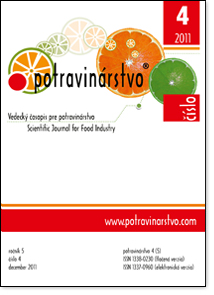Monitoring of genetic diversity in farmed deer populations using microsatellite markers
DOI:
https://doi.org/10.5219/172Keywords:
genetic variability, microsatellite markers, Red deerAbstract
Deer (Cervidaei) belong to the most important species used as farmed animals. We focused on assesing the genetic diversity among five deer populations. Analysis has been performed on a total of 183 animals originating from Czech Republic, Hungary, New Zealand, Poland and Slovak Republic. Genetic variability were investigated using 8 microsatellite markers used in deer. Statistical data of all populations we obtained on the basis of Nei statistics, using by POWERMARKER 3.23 programme. Graphical view of relationships among populations and individuals in the populations was obtained using the Dendroscope software. Molecular genetic data combinated with evaluation in statistical programmes could lead to a complex view of populations and diffrences among them.
Downloads
Metrics
References
ADESIYUM, A.A., TATINI, S.R., HOOVER, D.G., 1984. Production of enterotoxins by Staphylococcus hyicus. In Veter. Microbiol., vol. 9, 1984, p. 487-495. DOI: https://doi.org/10.1016/0378-1135(84)90069-5
BAUTISTA, L., GAYA, P., MEDINA, M., NUNEZ, M., 1988. A quantitative study of enterotoxin production by sheep milk staphylococci. In Appl. Environ. Microbiol., vol. 54, 1988, p. 566-569. DOI: https://doi.org/10.1128/aem.54.2.566-569.1988
BEATRIZ, M., BORELLI, E.G., FERREIRA, I.C., LACERDA, D.A., SANTOS, L.S., CARMO, R.S., DIAS, M., CRISOLITA C., SILVA, C.A., 2006. Enteroxigenic Staphylococcus spp. and other microbial contaminants during production of Canastra cheese, Brazil. In Braz. J. Microbiol., vol. 37, no. 4, 2006, p. 545-550. DOI: https://doi.org/10.1590/S1517-83822006000400026
BECKER, K., ROTH, R., PETERS, G., 1998. Rapid and specific detection of toxigenic Staphylococcus aureus: use of two multiplex PCR enzyme immunoassays for ammplification and hybridization of staphylococcal enterotoxin genes, exfoliative toxin genes, and toxic syndrome toxin-1 gene. In J. Clin. Microbiol., vol. 36, 1998, p. 2548-2553. DOI: https://doi.org/10.1128/JCM.36.9.2548-2553.1998
BECKER, K., KELLER, B., VON E.C., BRÜCK, M., LUBRITZ, G., ETIENNE, J., PETERS, G.,2001. Enterotoxigenic potential of Staphylococcus intermedius. In Appl. Environ. Microbiol., vol. 67, 2001, p. 5551-5557 DOI: https://doi.org/10.1128/AEM.67.12.5551-5557.2001
BERGDOLL, M.S., 1991. Staphylococcus aureus ,In J. of the Assoc. of Offic. Analyt. Chemists, vol. 74, no. 4, 1991, p. 706 – 710. DOI: https://doi.org/10.1093/jaoac/74.4.706
HARIHARAN, H., DONACHIE, W., MACALDOWIE, C., KEEFE G., 2004. Bacteriology and somatic cell counts in milk samples from ewes on a Scottish farm. In Can. J. Vet. Res., July, vol.68, no.3, 2004, p. 188–192.
VASIĽ, M., 2007. Aetiology of mastites and enterotoxin production by Staphylococcus spp. isolated from milk of two sheep herds. In Slovak J. Anim. Sci., vol. 40, 2007, p. 189-195.
VERNOZ, Y., ROZAN, D.C., MAZURY, C., PREVOST, G., LAPEYRE, C., BES, M., BRUN, Y., FlEURETTE, J., 1996. Enterotoxin production by coagulase- negative staphylococci isolated from goat’s milk a cheese. In Int. J. Food Microbiol., vol. 30, 1996, p. 271-280. DOI: https://doi.org/10.1016/0168-1605(96)00952-X
Downloads
Published
How to Cite
Issue
Section
License
This license permits non-commercial re-use, distribution, and reproduction in any medium, provided the original work is properly cited, and is not altered, transformed, or built upon in any way.






























